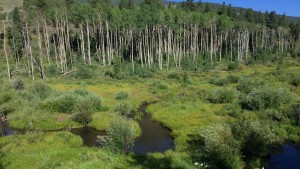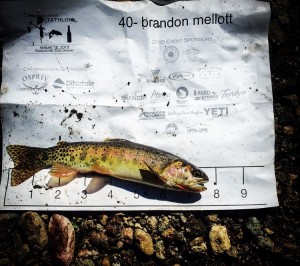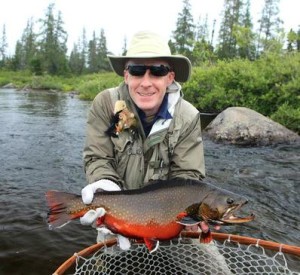By: Danielle Adams Three simple words.
Run. Fish. Beer.
Each might resonate individually to different folks, but there's a special breed out there who can see the true beauty in pursuing all three in the same day- and in unique circumstances- possibly all at once. 
As a seasoned runner himself, EPA fish biologist, Andrew Todd conceptualized and brought to life what has he considers the best triathlon ever. If a triathlon is defined as an athletic contest consisting of three different events, then the Rocky Mountain Flyathlon fits the bill- well if you count beer drinking as an athletic event.
By way of a course commencing with a scenic run in, followed by trail accessed fly fishing, ending in craft beer indulgence, Todd was able to combine several hobbies into one uniquely exciting event.
 The rules remain very uncomplicated, yet yield the best outcomes to those who are the most avid strategists. Complete the prescribed trail run, catch a fish at any point during the run, take a picture of said fish on your race bib, and do it all as quickly as possible. The bigger the fish, the more time is taken off at the end of your run- with a special double bonus for catching a native cutthroat trout.
The rules remain very uncomplicated, yet yield the best outcomes to those who are the most avid strategists. Complete the prescribed trail run, catch a fish at any point during the run, take a picture of said fish on your race bib, and do it all as quickly as possible. The bigger the fish, the more time is taken off at the end of your run- with a special double bonus for catching a native cutthroat trout.
As a biologist and sportsman, Todd has made the imperative connection between conservation and the art of angling. He notes that restoration and conservation of trout habitat goes hand-in-hand with promoting fly fishing as sport. Through this event he has offered an alternative way for fishermen and women to access especially rare trout watersheds- including native cutthroat waters.
Last year the Flyathlon sold-out with around 50 athletes who participated. The cap on the number of athletes is no accident. With education at the forefront, the conservation of the small stream fisheries that flyathletes will come in contact with, is kept in mind when assembling the cohort. Due to his background, Todd was able to recognized the potential danger in overwhelming these fish populations. The safety of the trout, habitat, and overall trail maintenance are fundamental to the Flyathlon mission, and overall goal of the event.

According to Todd, "relying on a crowdfunding model with our 501c3 partner Colorado Trout Unlimited, this past year, our flyathletes raised an incredible $22,200. At least 50% of this money will be re-invested into projects to maintain and enhance the trails, creeks and fisheries within the range of the Rio Grande cutthroat trout, ensuring that our activity is sustainable into the future."
Todd has three events planned for 2016, including two events in Colorado, and one in northern Idaho, see below for more details about each event.
If you feel like you have what it takes to be a flyathlete, please visit the website at www.flyathlon.com to get on the email list. If your organization would like to partner with or sponsor the Rocky Mountain Flyathlon in order to increase their impact, please contact Andrew Todd directly at cutthroat@gmail.com.
2016 Flyathlon Events:
Flyathlon: Saguache (permit pending) Fishing Difficulty: EASY Running Difficulty: MODERATE When: August 12th-14th, 2016 Where: Saguache, CO Number of Participants: 60
Flyathlon: Gunnison (permit pending) Fishing Difficulty: MODERATE Running Difficulty: EASY When: Late September, 2016 (hold the 23rd-25th for now) Where: Gunnison, CO Number of Participants: 60
Flyathlon: Idaho (permit pending) Fishing Difficulty: TBD Running Difficulty: TBD When: Late July, 2016 Where: Northern Idaho Number of Participants: 30-50






 The report focuses on the great work that sportsmen and women did to help these places become protected from land development under the Antiquities Act of 1906. These newest monuments will be protected due to their historic or scientific interest. All of these area protect the habitat and populations of wild animals, have easy public access, and the management of fish and wildlife populations will be retained by state fish and wildlife agencies.
The report focuses on the great work that sportsmen and women did to help these places become protected from land development under the Antiquities Act of 1906. These newest monuments will be protected due to their historic or scientific interest. All of these area protect the habitat and populations of wild animals, have easy public access, and the management of fish and wildlife populations will be retained by state fish and wildlife agencies. Merging the arts with adventure,
Merging the arts with adventure,  New to to Fishpond's 2016 line, the
New to to Fishpond's 2016 line, the 
 Thanks to the folks at
Thanks to the folks at  Snowpack is a seasonal accumulation of slow-melting snow, which becomes compressed in layers by its own weight over time. As there is more snow accumulation in a region, the snowpack becomes more dense. The denser the snow, the more water storage capability it has--a hard layer will have around a 40% water to 60% air ratio.
Snowpack is a seasonal accumulation of slow-melting snow, which becomes compressed in layers by its own weight over time. As there is more snow accumulation in a region, the snowpack becomes more dense. The denser the snow, the more water storage capability it has--a hard layer will have around a 40% water to 60% air ratio. watersheds to be at normal levels in order to flourish. Dissolved oxygen (DO) is fundamental to aquatic life. With higher levels of snowpack, there is more capability for dissolved oxygen in water due to higher water levels and colder temperatures. Cold water can hold more DO than warm water. Higher DO levels are achieved when water levels and flow rates are high and where the water is aerated in the rapids.
watersheds to be at normal levels in order to flourish. Dissolved oxygen (DO) is fundamental to aquatic life. With higher levels of snowpack, there is more capability for dissolved oxygen in water due to higher water levels and colder temperatures. Cold water can hold more DO than warm water. Higher DO levels are achieved when water levels and flow rates are high and where the water is aerated in the rapids. There are a few things to keep in mind in the event that snowfall patterns slow, and snowpack fails to develop as extensively as predicted. As the spring and summer months draw nearer, lower snowpack levels brings strained trout populations. In these circumstances,
There are a few things to keep in mind in the event that snowfall patterns slow, and snowpack fails to develop as extensively as predicted. As the spring and summer months draw nearer, lower snowpack levels brings strained trout populations. In these circumstances, 


 great way to save money. And like most things, the correct answer is, "It depends." The initial cost of purchasing the tools and materials can range anywhere from $50-200+ but, again, this depends on the quality and quantity of materials.
great way to save money. And like most things, the correct answer is, "It depends." The initial cost of purchasing the tools and materials can range anywhere from $50-200+ but, again, this depends on the quality and quantity of materials. This is great news for those along the Colorado River basin that are depending on a wet winter to bring life back to their crops, reduce drought conditions, and replenish
their reservoirs.
This is great news for those along the Colorado River basin that are depending on a wet winter to bring life back to their crops, reduce drought conditions, and replenish
their reservoirs.



